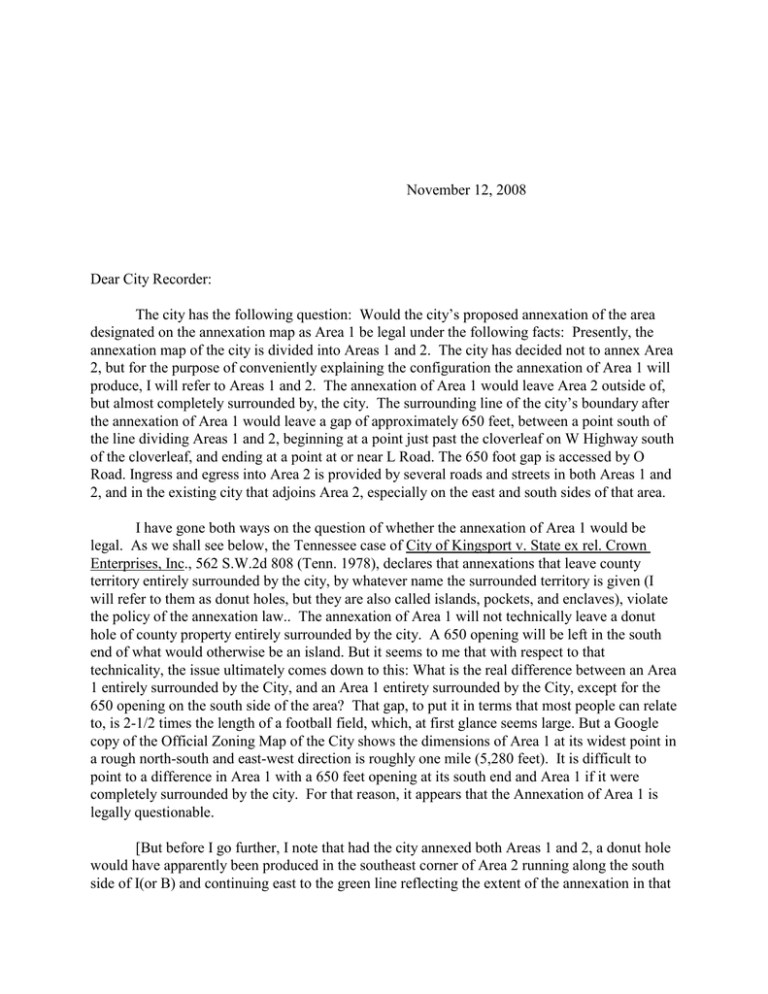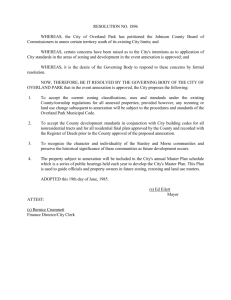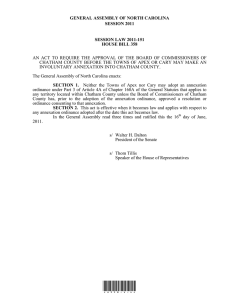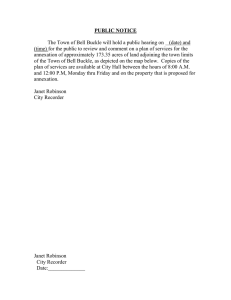November 12, 2008 Dear City Recorder:
advertisement

November 12, 2008 Dear City Recorder: The city has the following question: Would the city’s proposed annexation of the area designated on the annexation map as Area 1 be legal under the following facts: Presently, the annexation map of the city is divided into Areas 1 and 2. The city has decided not to annex Area 2, but for the purpose of conveniently explaining the configuration the annexation of Area 1 will produce, I will refer to Areas 1 and 2. The annexation of Area 1 would leave Area 2 outside of, but almost completely surrounded by, the city. The surrounding line of the city’s boundary after the annexation of Area 1 would leave a gap of approximately 650 feet, between a point south of the line dividing Areas 1 and 2, beginning at a point just past the cloverleaf on W Highway south of the cloverleaf, and ending at a point at or near L Road. The 650 foot gap is accessed by O Road. Ingress and egress into Area 2 is provided by several roads and streets in both Areas 1 and 2, and in the existing city that adjoins Area 2, especially on the east and south sides of that area. I have gone both ways on the question of whether the annexation of Area 1 would be legal. As we shall see below, the Tennessee case of City of Kingsport v. State ex rel. Crown Enterprises, Inc., 562 S.W.2d 808 (Tenn. 1978), declares that annexations that leave county territory entirely surrounded by the city, by whatever name the surrounded territory is given (I will refer to them as donut holes, but they are also called islands, pockets, and enclaves), violate the policy of the annexation law.. The annexation of Area 1 will not technically leave a donut hole of county property entirely surrounded by the city. A 650 opening will be left in the south end of what would otherwise be an island. But it seems to me that with respect to that technicality, the issue ultimately comes down to this: What is the real difference between an Area 1 entirely surrounded by the City, and an Area 1 entirety surrounded by the City, except for the 650 opening on the south side of the area? That gap, to put it in terms that most people can relate to, is 2-1/2 times the length of a football field, which, at first glance seems large. But a Google copy of the Official Zoning Map of the City shows the dimensions of Area 1 at its widest point in a rough north-south and east-west direction is roughly one mile (5,280 feet). It is difficult to point to a difference in Area 1 with a 650 feet opening at its south end and Area 1 if it were completely surrounded by the city. For that reason, it appears that the Annexation of Area 1 is legally questionable. [But before I go further, I note that had the city annexed both Areas 1 and 2, a donut hole would have apparently been produced in the southeast corner of Area 2 running along the south side of I(or B) and continuing east to the green line reflecting the extent of the annexation in that November 12, 2008 Page 2 area. In fact, there even appears to be an unannexed street that divides the part of the existing city that lies south of Area 2, and that runs both north and south from the vicinity of S Street and where it intersects with O Road west of the cloverleaf. I also note that the annexation map reflects what are apparently earlier annexations that left other donut holes in the city, the most prominent of which is in the vicinity of the half cloverleaf at the intersection of T and U streets]. I also wonder about the status of the street that runs east and west from that cloverleaf. It may reflect unannexed property. If it is true, the annexation of Area 1 may not be contiguous to the city.] Many of the cases dealing with annexations that leave islands of county property surrounded by a city analyze the question of whether the annexation is contiguous to the city. “Contiguous” is defined by Black’s Law Dictionary, 6th Ed. 1990, as “In close proximity; neighboring, adjoining; near in succession; in actual contact touching at a point or along a boundary; bounded or traversed by. The term is not synonymous with Avicinal.” But Tennessee’s annexation law does not mention the word “contiguous.” Tennessee Code Annotated, ' 6-51102, speaking of annexation by ordinance, says: “A municipality...may extend its corporate limits by annexation of such territory adjoining its existing boundaries....” Tennessee Code Annotated, 6-51-104, speaking of annexation by referendum, says, “A municipality...may propose extension of its corporate limits by annexation of territory adjoining to its existing boundaries.” But the Tennessee courts in Town of Bartlett v. City of Memphis, 482 S.W.2d 782, and State ex rel. Maury County Farmers Co-Op Corp. v. City of Columbia, 362 S.W.2d 210 (1962), expressly point to a requirement that “adjoining,” or “adjoining to” in the clear sense that those words mean “contiguous.” But the “adjoining” or “adjoining to” language in Tennessee Code Annotated, '' 6-51102 and 6-51-104, and the “contiguous” requirement laid down by the Tennessee courts in Town of Bartlett and Maury County Farmer’s Co-Op Corp., above, may not reflect the test of whether an annexation that leaves any donut hole, or near donut hole, is legal in Tennessee. The reason arises from the Tennessee case of City of Kingsport v. State ex rel. Crown Enterprises, Inc., 562 S.W.2d 808 (Tenn. 1978). There Crown Enterprises challenged Kingsport’s annexation of 806 acres, which included an 85-acre industrial park owned by Crown Enterprises and used by its subsidiary, Mason and Dixon Lines (M&D). The trial court found the annexation unreasonable for several reasons: the 85 acre site used by M&D was industrial; M&D provided virtually all its own services; the annexation of the M&D property was solely for the purpose of obtaining tax revenue in violation of Tennessee Code Annotated, section 6-51-103. In overturning the trial court, the Tennessee Supreme Court declared that, “The basic fallacy in the trial judge’s conclusion is that he treated the controversy as if the Crown-M&D Property were the only territory being annexed as opposed to being but a small portion of a substantially larger territory being annexed in good faith.” The Court was not impressed with November 12, 2008 Page 3 Crown Enterprise’s argument that M&D didn’t need city services because: The whole process of annexation would be frustrated if the city could only annex those properties then in need of city services. The result of this would tend to create islands of unincorporated areas within a city and the archipelagic monstrosity thus created would thwart the rendition of essential city services and would not be in the public interest. Appellees do not contest the annexation of the remaining property. Should we uphold their contention the result would be the creation of an 85 acre island or enclave, completely surrounded by the City of Kingsport. This area thus omitted would be within, but not a part of a city. Absent the most compelling considerations, such a situation would be intolerable and an annexation that produced such a result would not meet the test of reasonableness. [At 814.] [Emphasis is mine.] The Court in Crown Enterprises, Inc., said nothing about the lack of contiguity produced by such annexation; rather it declared that such an annexation “would not meet the test of reasonableness.” We shall see below that some courts have used the same test, conceding that an annexation that creates a donut hole of county property surrounded by a city is contiguous to the city. It can be argued that what the court said in Crown Enterprises, Inc. was dictum: a statement the court made that was not necessary to the resolution of that case, and is not, therefore, binding precedent. But whether or not that statement was dicta, it reflects a strong statement of policy made by the Tennessee Supreme Court about island or donut hole annexations that simply cannot be ignored by an annexing city where such a configuration is produced by the annexation. The concept of “archipelagic monstrosity” appears again in the Missouri case of Martee v. City of Kennett, 784 S.W.2d 621 (Mo. Ct. App. 1990). There apparently the annexations in question created what the court called “enclaves” totally surrounded by county property. The Missouri annexation statute required annexations that were “contiguous to existing corporate limits...” In overturning those annexations, the court declared that no Missouri case had ever declared that the creation of an unincorporated enclave was prohibited by the contiguity requirement in the Missouri annexation law, but pointed to some of the “guidelines” those courts had announced for determining whether an annexation was “reasonable” [Emphasis is mine.] One of the factors to consider in determining the reasonableness of a proposed annexation is whether it makes the city’s boundaries more regular. [Citation omitted by me.] [T]he city limits after annexation should include the annexed territory and describe [ ]the city and the annexed territory as one solid tact of land. [Citation omitted by me.] See Anno: What Land is Contiguous or Adjacent to Municipality so as to be Subject to Annexation, 49 A.L.R.3d 589, ' 17 (1972). The creation of such enclaves has been condemned in the following terms: [Here the Court cited verbatim the language I cited above from the Tennessee case of Crown Enterprises, Inc.] [At 625] Those “guidelines” could well appear in any future case involving donut or near donut hole annexations in Tennessee. Of course, one of those guidelines is already a Tennessee guideline, having come from Crown Enterprises, Inc. Crown Enterprises, Inc, also does not stand alone in Tennessee. In State ex rel. Earhart v. City of Bristol, 970 S.W.2d 948 (Tenn. 1998), the Tennessee Supreme Court held that Tennessee Code Annotated, section 6-51-103, which limited quo warranto annexation challenges to property owners inside the annexed territory and within 30 days of the date of annexation, applied only to challenges based on the reasonableness of the annexation. It permitted property owners annexed in 1995 by the City of Bristol to challenge a corridor annexation adopted in 1989; the territory annexed in 1995 was attached to the corridor annexed in 1989. Citing State ex rel. Collier v. City of Pigeon Forge, 599 S.W.2d 545 (Tenn 1980), which quoted Crown Enterprises, the Court frowned upon corridor annexations, declaring that, “As in any annexation, and more particularly one wherein a geometrically irregular parcel of land is annexed, the Court must scrutinize the stated and ostensible purpose of the annexation.” [At 995.] Earhart also said that: The majority of courts have interpreted the requirement that the annexed area be “contiguous” to not allow the annexation of thin strips of land to connect a larger parcel of land to a municipality. [Citation omitted.] These decisions articulate the principle implicit in the Tennessee statute. [At 954.] I see no reason why Earhart would not permit a challenge to the legality of a donut hole annexation and all annexations subsequent to, and attached to it, brought by a property owner perhaps several times removed from the annexation, and long after it occurred. It is also likely that the above cases permit the challenge of an annexation that produces a near donut hole of unannexed territory surrounded by the city. It appears not enough in Tennessee that an annexation be of territory “adjoining,” or “adjoining to” an existing city. If the Tennessee courts November 12, 2008 Page 5 see any annexation that reflects an unusual configuration as an “archipelagic monstrosity,” even if it technically meets the “adjoining” requirements, they can take the approach that the annexation is either unreasonable or not contiguous, or both. The annexation by the City of the area on the annexation map designated as Area 1 does not technically produce a donut hole annexation. Indeed, the annexation of Area 2 does not reflect a “lasso” or a narrow curved thin corridor annexation surrounding what is Area 2. Such lassos have frequently been the subject of annexation cases creating donut holes. Both Area 1 and 2, are presently bounded on the north, west and south by the City, at great depth. However, the annexation of Area 1 would produce what amounts to a narrow “corridor” into county territory, which is the only thing that breaks the surrounding boundary of the City. The question is whether such an annexation qualifies as an archipelagic monstrosity. I can find only one case that reflects an annexation challenged because it apparently created a donut hole, except for narrow opening in the donut. In City of Center Hill v. McBryde, 952 So.2d 599 (DCA 5th 2007), the annexation “created a 100-acre pocket of unincorporated territory (“the parcel”) surrounded by hundreds of acres of municipal property.” However, in Footnote 4, the court describes the configuration of “the unincorporated parcel as looking like a balloon on a string, should the annexation proceed.” That description suggests that the width of the “string” was the opening in the donut. [At 203] Florida law required that “Any annexation...be designed in such a manner as to ensure that the areas will be reasonably compact,” and that “compactness” required the “concentration of property in a single area and precludes any action which would create enclaves, pockets, or finger areas in serpentine patterns.” But the annexation statutes did not define the term “pockets.” The Court turned to the earlier case of City of Sunrise v. Broward County, 473 So.2d 1387 (Fla. 4th DCA 1985), in which the annexed property created “enclaves” of county property surrounded by city property, and fingers in a serpentine pattern. That court had declared that under the rules of statutory construction, this court concluded that a pocket is “a small isolated area or group.” [At 602] The annexation at issue in City of Center Hill, declared the court, also citing City of Sunrise, above, held that the annexation produced “a small isolated area or group,” and declared that: In order to understand the concepts of compactness and the prohibition against enclaves in the context of annexation proceedings, it is helpful to consider the general purpose and goals of municipal corporations as described by the attorney general in his opinion in 077-18, quoting from 56 Am.Jur.2d Municipal November 12, 2008 Page 6 Corporations, Etc. ' 69: The legal as well as the popular idea of a municipal corporation in this country, both by name and use, is that of oneness, community, locality, vicinity; a collective body, not several bodies, a collective body of inhabitantsBthat is, a body of people collected or gathered together in one mass, not separated into district masses, and having a community of interests because residents of the same place, not different places. So, as to territorial extent, the idea of a city is one of unity, not of plurality; of compactness or contiguity, of separation of segregation. [At 602] [Emphasis is the court’s.] The city argued that an earlier Florida case, City of Sanford v. Seminole County, 538 So.2d 113 (Fla. Th DCA 1989), had held that “pocket” annexations were legal when the pocket created was “small” and “isolated.” In that case, the “pockets” apparently involved annexations in a finger pattern, but were not winding or turning. But the court rejected that argument, reasoning that: The issue of whether a parcel of property is “small” and “isolated” is relative to, and necessarily dependent upon, the size and configuration of the parcel and the surrounding municipal property. Size, be it small or large is a relative term that can only be determined in relation to something else. Although we said in City of Sanford that a pocket in “a small isolated group or area,” we did so recognizing that whether a parcel is small and isolated must be determined in relationship to the overall scope and configuration of the parcel in question and the surrounding municipal property. That statutory requirement that pockets not be created by annexation was intended to insure that no vestiges of unincorporated property be left “in a sea of incorporated property.” Alison Yurko, Practical Perspective About Annexation in Florida: Making Sense of Florida Statutes Chapter 164 and 171 in 2003 and Beyond, 32 Stetson L.Rev. 517, 533 (2003). Given the configuration of the City, SSC’s property, and the parcel, that is precisely what would occur here.... Should the annexation proceed, an impermissible pocket, albeit one of approximately 100 acres, would be created. Given the scope of the overall annexation and the configuration of the properties, the parcel is, relatively speaking, small and isolated. November 12, 2008 Page 7 Although in absolute terms the 100 acre parcel is not insignificant, relative to the 1,235 acre annexation, a pocket is created. We conclude that the circuit court’s order property applied the statutory requirement that annexations be compact. [At 603.] Although the court did not make it an issue, the type of territory annexed undoubtedly influenced it in City of Center Hill. The 1,235 acre land to be annexed belonged to SSC [Sumner Cement Company] which also petitioned the city to use the land for a cement plant and lime rock quarry. In that sense, the 100 acre pocket might indeed have for all practical purposes found itself “small and isolated.” I do not know whether the Tennessee courts would adopt the “pocket” annexation approach of the Florida courts. There is no statute in Tennessee making the absence of “pockets” a part of the definition of compactness, or even a statute that requires the compactness of annexations. But significant about those cases is that they concede the contiguity of the annexations, and base their decisions on the question of whether the annexations are compact. But it seems clear from Crown Enterprises, Inc., that under the right circumstances, the “archipelagic monstrosity” test of the annexation at issue could include annexations of nearly any kind the court considers unusual. In that context, it is interesting to note that corridor, finger and strip annexations can be the opposite side of the coin from annexations that surround county property, except for a break in the boundary of the city property. Corridor, finger and strip annexations extend out from the municipality into the county and may create a peninsula or peninsulas of city property in the county, and a donut hole annexation broken by a relatively small interruption in the border around the city property surrounding the donut hole opens into county property that creates a peninsula of county property almost surrounded by city property. Needless to say, it is likely that the annexation of Area 2 first might appear to be more logical than the annexation of Area 1. A court considering the legality of the annexation of Area 2 is bound to wonder why Area 1 was not annexed first, which would have intercepted any problem with the creation of a near donut hole in Area 1 by the annexation of Area 2. But Area 1 is itself bordered entirely on its north side at great depth, and, standing on its own, appears to be a logical extension of the city. Even if it could be called a corridor annexation because it takes in what appears to be a significant length of U street to take in a cloverleaf on the eastern edge of Area 2 and part of the intersecting W Highway east and west of the cloverleaf, it takes in people and property in addition to the right of way. For that reason it appears to satisfy State ex rel. Collier and State ex rel. Earhart v. City of Bristol. Of course, the question of whether the future annexation of Area 1 would be legal, does not necessarily intercept the question of whether the annexation of Area 1 now would be legal. November 12, 2008 Page 8 But if the courts must scrutinize the ostensible purpose of geometrically irregular pieces of land, under State ex rel. Collier v. City of Pigeon Forge and City of Kingsport v. State ex rel. Crown Enterprises, Inc., some scrutiny of the city’s future plan for Area 2 after the annexation of Area 1 seems pertinent to the question of whether the annexation of Area 1 is “reasonable” and/or contiguous. The nagging question is whether what amounts to a county hand roughly a mile long and a mile wide inserted into a complete municipal pants pocket, except for a pocket opening 650 feet wide for the county wrist attached to the county hand to stick out of the pocket, is a geometric configuration that will satisfy the courts. Put in those kinds of terms, that configuration does not sound very encouraging. But it is difficult from looking at the annexation map to see the pocket (Area 2) as “isolated.” It is not totally surrounded by the city, and is criss-crossed with a larger network of county roads and city streets than appears to be the case in Area 1. However, the “isolation” of which the cases speak when they deal with donut hole annexations seems to me more of a philosophical than of a practical kind, except perhaps for the confusion that might exist with respect to which government in the donut hole or near donut hole is the one responsible for municipal or county services. If one looks at the annexation map, one can see that there is probably a great deal of travel and commerce between Areas 1 and 2, and that as a practical matter, that probably would not change if Area 2 were annexed and created the near donut hole in Area 1. Most people who do that traveling or engage in that commerce might not care a great deal on a day-to-day basis in which government the territory in the donut hole lies, and may not remotely feel “isolated.” But philosophically, they may care a great deal whether the territory lies in the city or the county. The courts may also care a great deal when they look at the map and see that there is a separation of a group of county residents and county property from the “municipal sea” that surrounds them on almost every side. That separation violates the principal that a city is supposed to reflect an area containing city property, no matter the absence of any real or practical impact resulting from the mixture of two governments in part of the territory. The rhetoric of some courts about “archipelagic monstrosities” and the “isolation and separation” of people and territory that result from annexations of certain geometric patterns seem to me grossly overblown, but the courts are still in charge. . The City’s proposal to annex both Areas 1 and 2 itself indicates the city’s intent not to isolate, or at least not to leave in isolation, Area 1, and further indicates a future intent to bring that area into the city. I have not checked, but I suspect that the residents of Area 1 already receive all or most city utility services, and that the city will be better prepared to provide other city services to that area in the future. In theory, that will make Area 1 a future prime candidate for annexation, and would help the city to successfully meet any challenge that the annexation is either “unreasonable for the overall well-being of the communities involved,” or that “the health, safety and welfare of the citizens and property owners of the municipality and [the annexed territory will not be materially retarded in the absence of such annexation,” under Tennessee November 12, 2008 Page 9 Code Annotated, ' 6-58-111. In fact, it is almost ironic that the question of whether those two burdens of proof were alternative burdens was resolved in State ex rel. Tipton v. City of Knoxville, 205 S.W.3d 456 (Tenn. Ct. App. 2006) (appeal to Tennessee Supreme Court denied October 2, 2006), which involved a small parcel of land in the county deep inside the City of Knoxville along one of its busiest streets, and that was completely surrounded by city property. The court was silent as to the legal merits or demerits of the annexation or annexations that had created that island a decade earlier. But it concluded that it would be almost impossible to argue that the city’s annexation was unreasonable under those circumstances. As to the second alternative burden of proof, the fact that the territory was already receiving city services indicated that it needed them. But as I said above, the city’s intent with respect to Area 1 does not alter the fact that the annexation of Area 2 creates the near donut hole in Area 1. It may be that the courts may not see a problem with that near donut hole, or if they see a problem, they may look at Areas 1 and 2 as a unit, and see them as a future unit, and will uphold the annexation of Area 2 first. But I do not feel comfortable with that kind of optimistic conclusion. Sincerely, Sidney D. Hemsley Senior Law Consultant SDH/




